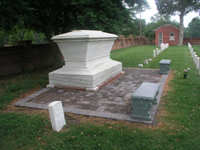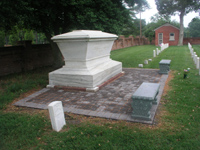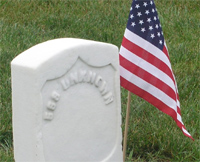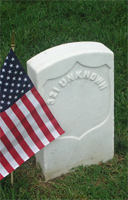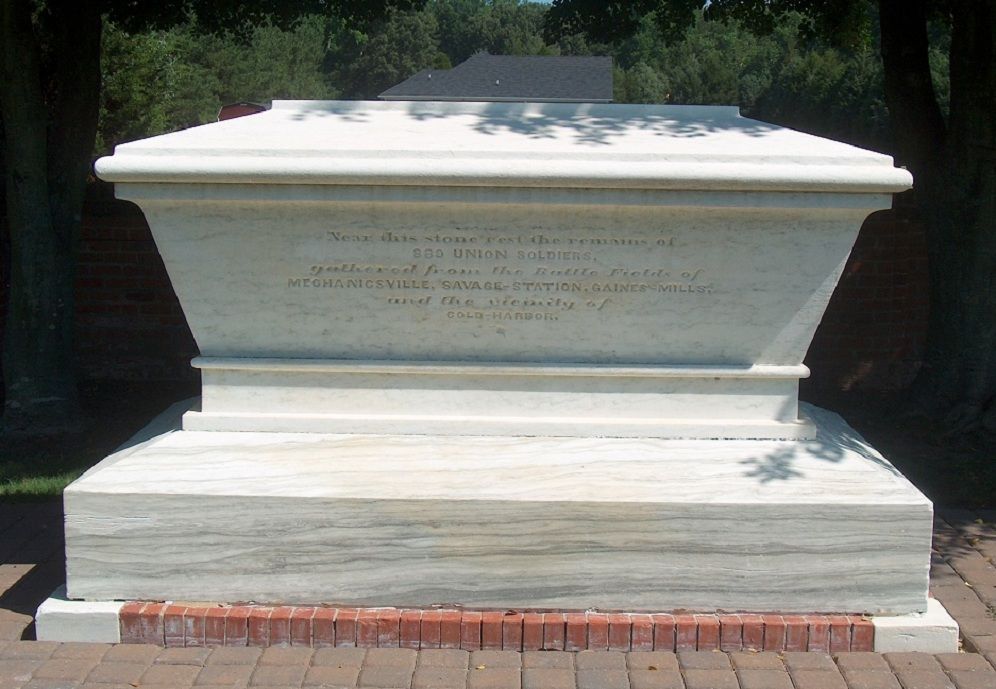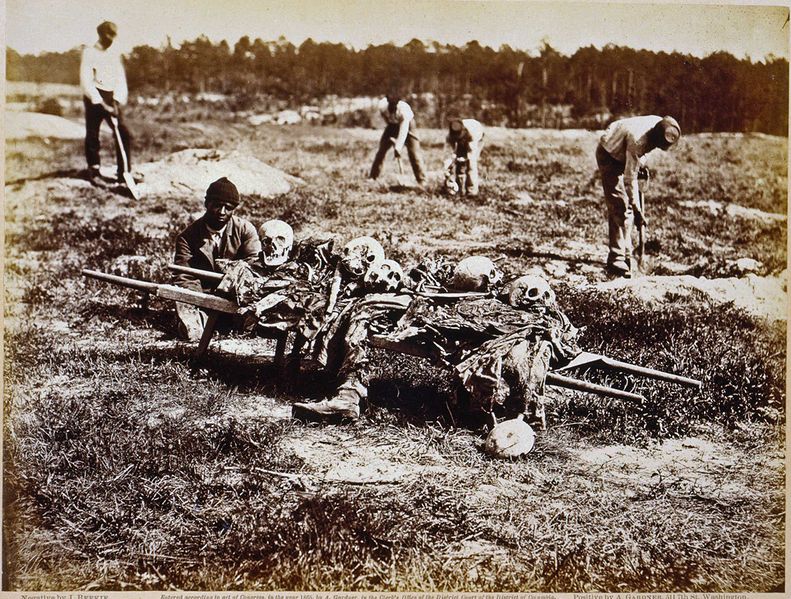A large white marble monument in the shape of a sarcophagus sits between the two burial trenches. It was erected at Cold Harbor in 1877 by the U.S. government. The inscription reads: "Near this stone rests the remains of 889 Union soldiers gathered from the Battlefields of Mechanicsville, Savage's Station,Gaines's Mills (sic), and the vicinity of Cold Harbor."
Casual visitors to the cemtery often erroniously assume that the 889 unknowns are either buried beneath the monument itself or that the monument commemorates the individual graves of other unknowns scattered throughout the cemetery. The surface of the trenches are level to the ground and not immediately apparent to the visitor, however their existence is marked by two small white headstones near the eastern and western walls of the cemetery. They are placed perpandicular to the other headstones in the cemetery, most of which face south toward the cemetery entrance. The mass graves lie in the grassy areas between the smaller tombstones and the larger monument. The headstones sit at the southwestern and southeastern corners of the trenches and simply read "568 Unknowns" and "321 Unknowns". The back of the headstones are etched with "Trench 1" and "Trench 2" respectively. The exact length and width of the trenches are unknown; their outline is not marked on the surface of the ground, however the earth is somewhat uneven at those locations. The turf above the trenches is the same thick Kentucky Blue Grass present throughout the cemetery.
During the Civil War, soldiers would often initially receive only hasty burials on the field near where they fell. Due to the vast number of casualties from the war, few attempts were made to give the dead a more proper and permanent burial until after the war was over (Gettysburg National Cemetery being a notable exception for the Union dead).
Collection of the Federal dead at the Cold Harbor began in April 1865, almost a year after the battle. By that time many of the graves had been exposed by the actions of weather and animals. Wartime photographer Alexander Gardner and his assistants took one of the most famous photographs of the war at Cold Harbor displaying skulls and bones piled high on a stretcher while USCTs (black Union troops) collect other bones in the background. White Union troops were also involved in the 1865 operation but were not photographed. The 1865 reburials primarily served to get the remains underground until land could be purchased for a permanent cemetery. Another year passed before the Cold Harbor National Cemetery was established.
During the post-war re-burial operations there was no attempt to reassemble scattered bones into individiual skeletons. It was customary to count one skull and one pelvis as "one body" and then group arm bones, leg bones, rib cages, hands, feet, and vertabre together by type into the trench graves; skulls with skulls, fibias with fibias, ribs with ribs, and so on.
Cold Harbor National Cemetery is located at what was the approximate center of the seven mile long Union battleline of the June 1-12, 1864 battle of Cold Harbor. Small portions of the battlefield are preserved nearby by the National Park Service and Hanover County. The Richmond National Battlefield Park maintains a small vistor center and museum approximately 1/2 mile from the cemetery.
A large white marble monument in the shape of a sarcophagus sits between the two burial trenches. It was erected at Cold Harbor in 1877 by the U.S. government. The inscription reads: "Near this stone rests the remains of 889 Union soldiers gathered from the Battlefields of Mechanicsville, Savage's Station,Gaines's Mills (sic), and the vicinity of Cold Harbor."
Casual visitors to the cemtery often erroniously assume that the 889 unknowns are either buried beneath the monument itself or that the monument commemorates the individual graves of other unknowns scattered throughout the cemetery. The surface of the trenches are level to the ground and not immediately apparent to the visitor, however their existence is marked by two small white headstones near the eastern and western walls of the cemetery. They are placed perpandicular to the other headstones in the cemetery, most of which face south toward the cemetery entrance. The mass graves lie in the grassy areas between the smaller tombstones and the larger monument. The headstones sit at the southwestern and southeastern corners of the trenches and simply read "568 Unknowns" and "321 Unknowns". The back of the headstones are etched with "Trench 1" and "Trench 2" respectively. The exact length and width of the trenches are unknown; their outline is not marked on the surface of the ground, however the earth is somewhat uneven at those locations. The turf above the trenches is the same thick Kentucky Blue Grass present throughout the cemetery.
During the Civil War, soldiers would often initially receive only hasty burials on the field near where they fell. Due to the vast number of casualties from the war, few attempts were made to give the dead a more proper and permanent burial until after the war was over (Gettysburg National Cemetery being a notable exception for the Union dead).
Collection of the Federal dead at the Cold Harbor began in April 1865, almost a year after the battle. By that time many of the graves had been exposed by the actions of weather and animals. Wartime photographer Alexander Gardner and his assistants took one of the most famous photographs of the war at Cold Harbor displaying skulls and bones piled high on a stretcher while USCTs (black Union troops) collect other bones in the background. White Union troops were also involved in the 1865 operation but were not photographed. The 1865 reburials primarily served to get the remains underground until land could be purchased for a permanent cemetery. Another year passed before the Cold Harbor National Cemetery was established.
During the post-war re-burial operations there was no attempt to reassemble scattered bones into individiual skeletons. It was customary to count one skull and one pelvis as "one body" and then group arm bones, leg bones, rib cages, hands, feet, and vertabre together by type into the trench graves; skulls with skulls, fibias with fibias, ribs with ribs, and so on.
Cold Harbor National Cemetery is located at what was the approximate center of the seven mile long Union battleline of the June 1-12, 1864 battle of Cold Harbor. Small portions of the battlefield are preserved nearby by the National Park Service and Hanover County. The Richmond National Battlefield Park maintains a small vistor center and museum approximately 1/2 mile from the cemetery.
Bio by: JEY
Advertisement
Explore more
Sponsored by Ancestry
Advertisement
